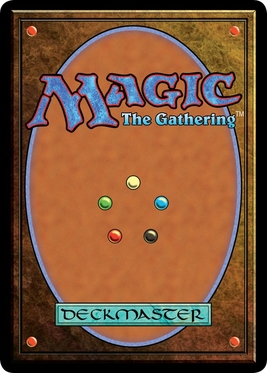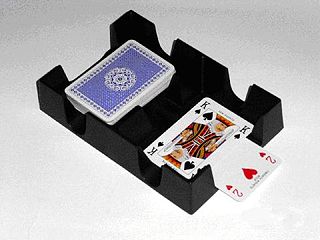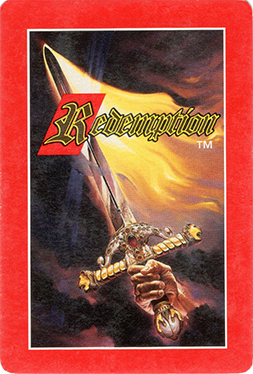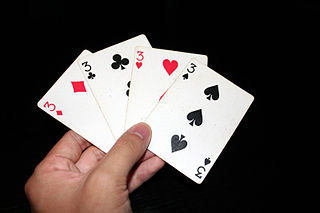
Magic: The Gathering is a tabletop and digital collectible card game created by Richard Garfield. Released in 1993 by Wizards of the Coast, Magic was the first trading card game and had approximately thirty-five million players as of December 2018, and over twenty billion Magic cards were produced in the period from 2008 to 2016, during which time it grew in popularity.

Canasta is a card game of the rummy family of games believed to be a variant of 500 Rum. Although many variations exist for two, three, five or six players, it is most commonly played by four in two partnerships with two standard decks of cards. Players attempt to make melds of seven cards of the same rank and "go out" by playing all cards in their hands. It is "the most recent card game to have achieved worldwide status as a classic".

Shithead is a card game, the object of which is to lose all of one's playing cards. The game became popular among backpackers in the late 20th century. Although the basic structure of the game generally remains constant, there are regional variations to the game's original rules.

Crazy Eights is a shedding-type card game for two to seven players and the best known American member of the Eights Group which also includes Pig and Spoons. The object of the game is to be the first player to discard all of their cards. The game is similar to Switch and Mau Mau.

A Game of Thrones: The Card Game is an out-of-print collectible card game produced by Fantasy Flight Games. It is based on A Song of Ice and Fire, a series of novels written by George R. R. Martin. The first set was Westeros Edition and was released in August 2002. It has since won two Origins Awards. The game's primary designer is Eric Lang, the lead developer is Nate French, with Damon Stone serving as associate designer.
The game of Bartok, also known by a number of other names, such as Wartoke, Warthog, Bartog, Bentok, Last One Standing or Bong 98, is a card game popular in Australia where the winner of each round invents a new rule which must be obeyed for the remainder of the game. It belongs to the "shedding" or Eights family of card games, whereby each player tries to rid themselves of all of their cards. The game progresses through a series of rounds with a new rule being added in each round, thus making the game increasingly complex as it progresses. These newly introduced rules may modify any existing rules.

Rummy is a group of games notable for similar gameplay based on matching cards of the same rank or sequence and same suit. The basic goal in any form of rummy is to build melds which can be either sets or runs and either be first to go out or to amass more points than the opposition.
A Game of Thrones is a strategy board game created by Christian T. Petersen and published by Fantasy Flight Games in 2003. The game is based on the A Song of Ice and Fire series of high fantasy novels by George R. R. Martin. It was followed in 2004 by the expansion A Clash of Kings, and in 2006 by the expansion A Storm of Swords.

Redemption is a collectible card game based on the Bible. It involves Biblical characters, places, objects, and ideas. The object of the game is for players to use their Heroes to rescue Lost Souls by defeating their opponent's Evil Characters, with the first player to rescue five Lost Souls winning the game. Redemption was first published in July 1995 by Cactus Game Design and its creator, Rob Anderson, continues to develop and produce the game and is the final authority on rulings.

Desmoche is a popular rummy card game usually played for small stakes which closely resembles other games in the rummy family, like Conquian and gin rummy, more than poker. It was probably devised in Nicaragua in the first half of the 20th century.

In the Dungeons & Dragons (D&D) role-playing game, Bahamut is a powerful draconic deity, who has the same name as Bahamut from Arabic mythology.
Yaniv, also known as Jhyap, Jafar, aa’niv or Minca, is a card game popular in Israel. It is a draw and discard game in which players discard before drawing a new card and attempt to have the lowest value of cards in hand. The game is considered a backpackers game in Israel, and it's popular among soldiers and young adults returning from long backpacking trips.

Wyvern is an out-of-print collectible card game featuring dragons and wyverns battling for treasure. The game was produced by U.S. Games Systems, with the first, "Premiere Limited", card set launched in January 1995. In 1997, the "Kingdom Unlimited" edition was released, featuring 277 cards, and marking the end of production.
Grave Robbers from Outer Space (GROS) is a card game designed by Stephen Tassie and published by Z-Man Games. GROS parodies movies and movie clichés, especially those from science fiction and horror movies. It is played with a specially designed 120 card deck.
The Catan Card Game, originally named The Settlers of Catan: The Card Game, is a card-game adaptation of The Settlers of Catan board game. It is a member of the Catan series of games developed by Klaus Teuber and published by Kosmos in German, and by Mayfair Games in English. The Catan Card Game is a two-player game, although the rules can be accommodated as to allow players to share a set or for each player to have their own, as is intended for tournament play. Seven expansions of the Catan Card Game have also been released.

Warrior Knights is a board game for 2–6 players originally published by Games Workshop in 1985, and later published by Fantasy Flight Games in 2006. Each player takes the role of a Baron vying to claim the throne of an unnamed kingdom. Gameplay revolves around raising an army, obtaining enough money to maintain that army, and gaining influence through a variety of means.

Ninety-nine is a simple card game based on addition and reportedly popular among the Romani people. It uses one or more standard decks of Anglo-American playing cards in which certain ranks have special properties, and can be played by any number of players. During the game, the value of each card played is added to a running total which is not allowed to exceed 99. A player who cannot play without causing this total to surpass 99 loses that hand and must forfeit one token.
The following is a glossary of poker terms used in the card game of poker. It supplements the glossary of card game terms. Besides the terms listed here, there are thousands of common and uncommon poker slang terms. This is not intended to be a formal dictionary; precise usage details and multiple closely related senses are omitted here in favor of concise treatment of the basics.

Taki is a card game developed by Israeli game inventor Haim Shafir. The game is an advanced variant of Crazy Eights with a special card deck and extended game options. In its basic form it resembles UNO. It was introduced in 1983 by Shafir Games. The game cards were designed by Israeli artist Ari Ron.

Star Realms is a card-based deck building science-fiction tabletop game, designed by Rob Dougherty and Darwin Kastle and published in 2014 by Wise Wizard Games. The game started out as a Kickstarter campaign in 2013. The goal of Star Realms is to destroy opponents by purchasing cards using "trade" points and using these cards to attack an opponent's "authority" using "combat" points. The game takes place in a distant future where different races compete to gain resources, trade and outmaneuver each other in a race to become ruler of the galaxy.












